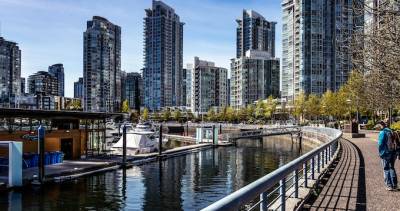Elspeth Pratt builds outside the rules
Late winter sunshine streams into Elspeth Pratt’s Vancouver studio, articulating the odd angles and unexpected materials of the sculptures mounted there. Abstract forms, loaded with meaning, hang on the walls or lean against them. One work-in-progress—a low stack of slightly tilted wooden boxes, one of them balanced on an empty pop can—stands amid tools and sawdust on the concrete floor. All await crating and transport to the Emily Carr Institute’s Charles H. Scott Gallery, where they will be on exhibit from March 11 to April 20. Although Pratt says she’s having difficulty assigning titles to her individual works, she has chosen a name for her solo show: Nonetheless.
“I was thinking about the kind of materials that I like to work with,” she says. “They’re materials that most people ignore. As well, I was thinking that the buildings that I was interested in were kind of marginalized. Nonetheless made sense.” Pratt’s media here include corrugated cardboard, textured vinyl cloth, and spongy carpet underlay. In the past, she has incorporated everything from polystyrene insulation to Formica, in small sculptures that challenge traditions of monumentality, permanence, and the use of precious materials such as bronze and marble.
Recalling her art education at the universities of Manitoba and British Columbia in the late 1970s and early 1980s, Pratt says, “I loved three-dimensional objects. I didn’t understand why they had to be made out of materials that were very expensive.” Drawn from the unglamorous realms of packing, building, and plumbing, her media evoke their homely origins while assuming new meanings within a fine-art context. They also reiterate, in an antiheroic way, Pratt’s architectural themes. These have included explorations of semipublic areas such as museums, shopping malls, and office towers in order to spotlight issues of spatial organization and social manipulation. “I’m interested in the built environment and the way it controls how we negotiate space,” she says.
Although Pratt’s sources may be quite specific, her art is about ideas rather than direct representation. “Whenever the work starts to get a little bit too close to actually looking like architecture, then I have to pull back.” The marginal buildings that serve as the departure point for many of the sculptures in Nonetheless are the improvised housing found in favelas, the shanty towns that have grown up spontaneously on the edges of cities and large towns in Brazil and other South American countries.
“I’ve become interested in the kind of architecture that develops at the outskirts—not the regulated architecture, but often what’s generated by people who have no choice.” Favela dwellers, known as favelados, are extremely poor, and Pratt hastily adds that she’s not trying to romanticize their living conditions. Still, she says, “they’re not restricted by bylaws and building regulations.”¦There’s a lot more experimentation, and interesting issues are raised around alternative ways of structuring space.” Favelados make extensive use, too, of scavenged, discarded, and unconventional materials, in contrast with the costly and wasteful building practices of wealthy nations.
Although Pratt makes references in Nonetheless to modern and postmodern buildings in Berlin and Tokyo, the parallels between her art and the favelas that intrigue her are numerous. There’s the use of nonconforming materials, inventive shapes, provisional construction—and unencumbered originality.















Comments